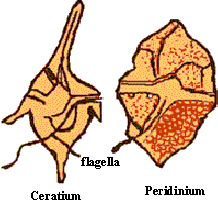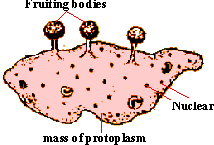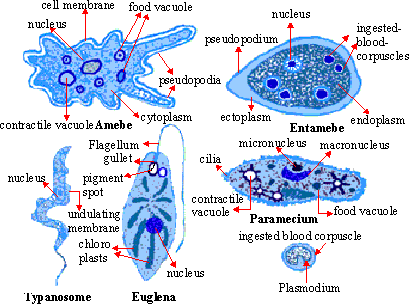|
PinkMonkey Online Study Guide-Biology

Figure 14.22 Dinoflagellates
Common life-cycle: Asexual reproduction takes
place by simple cell division (fission) or by zoospore formation. Recently
sexual reproduction by isogamy has been reported in some.
The examples are Ceratium, Noctiluca, Peridinium,
Ganyaulux.
Economic importance : They form an important constituent
of marine plankton and thus play an extremely important role in the aquatic
food web. A number of dinoflagellates like Ganyaulux are toxic, forming
red tides killing a number of fish. Some species cause dermatitis
in swimmers. They reproduce both sexually and asexually and the life history
shows alternation of generations as shown by diatoms.
(B) Slime molds
General account: Slime mold is a mass of naked protoplasm without a rigid cell wall. It creeps along the substratum by ameboid movements and engulfs spores, bacteria and particulate debris of the substratum on which it grows. It commonly reproduces by structures called fruiting bodies which produce spores.

Figure 14.23 Slime mold
There are two types of slime molds, viz., acellular and
cellular. Acellular slime molds have a vegetative body which is a multinucleated
mass of protoplasm called plasmodium. It starts its life as a single diploid
cell showing ameboid movements. Soon the nucleus divides repeatedly forming
a large mass of naked protoplasm with number of nuclei. Every now and
then it changes its shape and grows. Under unfavorable conditions, it
develops little mounds on plasmodium, each of which gives a stalk bearing
a sporangium at the tip. The spores are formed by meiosis, hence
they are haploid. Each spore produces one to four flagellate spores which
behave like undifferentiated gametes and fuse in pairs to form diploid
zygotes. The zygote divides repeatedly by mitosis to form new plasmodium.
Economic importance: In recent years slime molds have become important tools of research to study structure, streaming of movements and the physiology of protoplasm.
(C) Protozoans

Click here to enlarge
Figure 14.24 Protozoans
These are the protists which are more like animals. They are
unicellular organisms found in fresh water, salt or any moist surroundings.
They may be free living or parasitic, solitary or found in loose colonies.
General account : They are distinguished
by the following characteristics :
(i) The body is covered by plasma membrane or labile pellicle and contains one or many nuclei.
(ii) They are generally motile. Locomotion is carried out by flagella, cilia or pseudopodia.
(iii) Most of them are holotrophic though some are saprophytic and others parasitic in nutrition.
(iv) They show different organelles (cell organs)
like food vacuoles, contractile vacuoles and, in some, cytostome and
cytopharynx to perform various functions of life.
(v) They are sensitive to various external stimuli like touch, temperature, light etc.
|